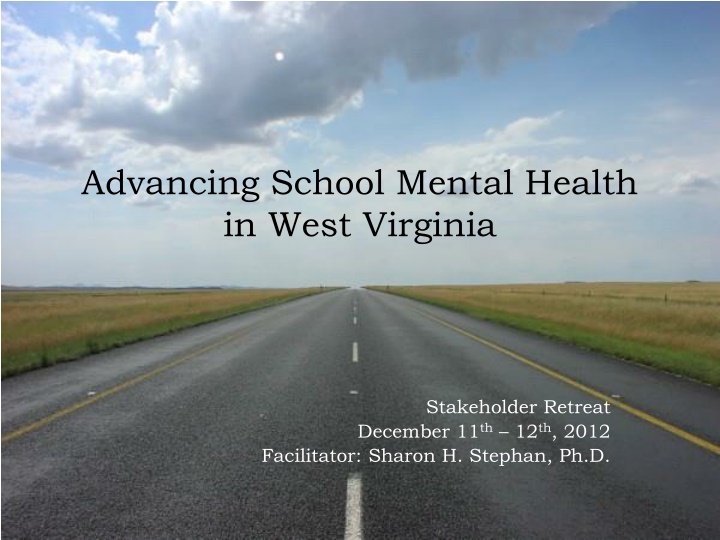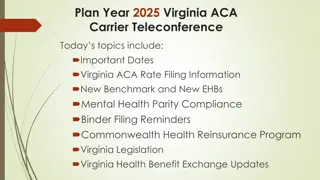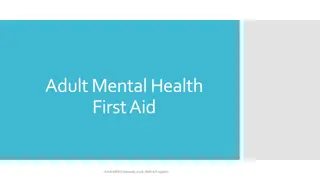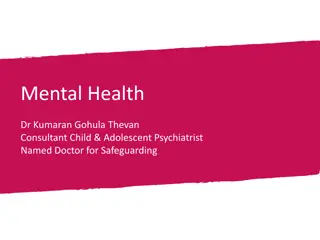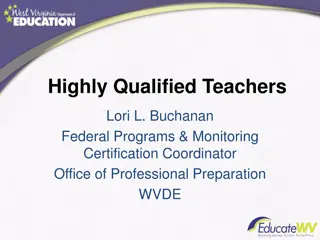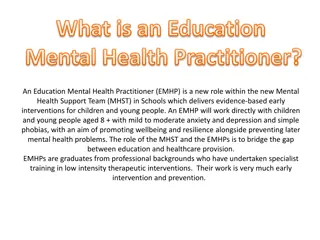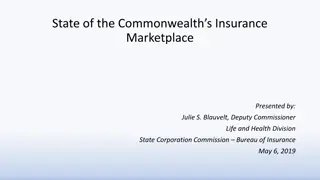Advancing School Mental Health in West Virginia
Stakeholder retreat held on December 11th-12th, 2012, facilitated by Sharon H. Stephan, Ph.D., focusing on initiatives, systems of care, critical factors, and capacity building for school mental health in West Virginia.
Download Presentation

Please find below an Image/Link to download the presentation.
The content on the website is provided AS IS for your information and personal use only. It may not be sold, licensed, or shared on other websites without obtaining consent from the author.If you encounter any issues during the download, it is possible that the publisher has removed the file from their server.
You are allowed to download the files provided on this website for personal or commercial use, subject to the condition that they are used lawfully. All files are the property of their respective owners.
The content on the website is provided AS IS for your information and personal use only. It may not be sold, licensed, or shared on other websites without obtaining consent from the author.
E N D
Presentation Transcript
Advancing School Mental Health in West Virginia Stakeholder Retreat December 11th 12th, 2012 Facilitator: Sharon H. Stephan, Ph.D.
Introductions Please share with the group: 1. Your name 2. Your role 3. Why school mental health matters (picture or ideas on cardstock)
Day 1 - Specific initiatives/efforts relevant to forward planning Department of Health and Human Resources WV Department of Education Marshall University Local Examples Others Youth and Family Involvement /Engagement FQHCs
Day 2 Agenda Background information Systems of Care 10 Critical Factors West Virginia Goals Survey Results Goals overview, dot voting on priorities Goal refinement and progress small groups
Systems of Care Definition A system of care structure is a coordinated network of mental health and other services designed to serve families with children who have complex mental health needs, and may be receiving services from more than one service sector (Stroul, 2002). History Core Values Family-driven Youth-guided Cultural and linguistic competence Individualized and community-based Evidence-based
10 Critical Factors to Advancing School Mental Health
School Mental Health Capacity Building Partnership (SMH-CBP) To build capacity of state and local education agencies, and their partners, in school mental health Five-year cooperative agreement Centers for Disease Control and Prevention, Division of Adolescent and School Health (DASH)
Stakeholder discussion groups Site visits to MO, MD, OH, OR Three discussion groups with adults Approx 30 stakeholders included: Mental health Family members/advocates Education Health Youth development Follow-up Final Product: Ten Critical Factors to Advancing School Mental Health
About Ten Critical Factors to Advancing SMH Developed at the state level but can apply to school districts as well Identified through qualitative analysis of cross-cutting themes Strategies developed through iterative review process Not sequential Not one size fits all can be implemented differently
Ten Critical Factors Vision and shared agenda Infrastructure and systems of accountability Feasible and sustainable funding Connection to academic outcomes Family and youth partnerships 1. 2. 3. 4. 5.
Ten Critical Factors (cont.) Cultural competence Training and staff development Best practices Coordination of resources Data collection and evaluation 6. 7. 8. 9. 10.
Using Ten Critical Factors Provides a framework to advance SMH at state or school district level Use at any point in a planning or implementation process Assess baseline or current status Develop consensus about priorities with multiple stakeholders Seek continuous feedback from a larger diverse group of stakeholders Monitor progress
Pre-Assessment Survey Results Anonymous, online survey collected early December 2012 31 respondents; 15 (48%) steering committee members Domains queried: Critical Factors Suggestions Challenges Getting Involved Steering Committee Structure Leadership, Staffing, Relationships Mission, Strategies, and Action Plans Participation
Survey Results: Critical Factors Not in Place Fully in Place 1 2 3 4 5 6 1. Vision and shared agenda 3.84 2 .Infrastructure and systems of accountability 3.61 3. Feasible and sustainable funding 3.26 4. Connection to academic outcomes 4.1 5. Family and youth partnerships 2.77 6. Cultural competence 3.81 7. Training and staff development 3.68 8. Best practices 3.81 9. Coordination of resources 3.19 10. Data collection and evaluation 3.32
What suggestions do you have for West Virginias Expanded School Mental Health Steering Committee? Expand Statewide understanding, importance, and acceptance of Expanded School Mental Health 'Shop' premier ESMH programs Work with WVDE leadership to develop policy implications for integrating expanded mental health in all schools Present mental health initiative to State Board of Education Formulating a list of core school mental health problems for which there should be access to competent care. More awareness of what it can accomplish and how it can assist schools. I know that there has been a lot of communication but we have to continue to get the information out there with the success it has had on the schools that have ESBMH. improve data/outcome collection so it relates to administrators, law makers, funders Training Work to integrate into pre-service programs Develop online training modules for a myriad of planning and implementation areas to support ease of ongoing professional development and implementation in schools. Identify the core competencies (based on the above) for professionals providing mental health services for students. Implement training (combination of group workshops and on-line training modules) to promote competence in the core competencies. Teacher training is crucial. Teachers are not sufficiently training in mental and behavioral health issues of children to effectively deal with them in the classroom.
Utilize Partnerships/Resources Engage new partnerships or revitalize existing/former partnerships Connect ESBMH efforts with Safe and Supportive Schools, there is a high interest in mental health. Also work with the WV Council for the Prevention of Suicide and the Governor's Substance Abuse Taskforce. Coordination and collaboration (resource sharing) to develop a sustainable, outcome oriented plan for ESMH. School systems continue to work with community partners. Every West Virginia school has a Local School Improvement Council (LSIC). LSICs should be involved in this effort. Funding Create a body that focuses on securing funding sources including advocating with the governor and state legislators Medical (Medicaid, CHIP, etc.) services funding needs to be flexible to allow for school based services. Funding for implementation should be provided. Need to know what plan the state mental health authority has for these and what is the funding model for payment and how the MH delivery system will work as a whole, and where school MH svc's fit in his. SECURE A STABLE, SUSTAINABLE FUNDING SOURCE, OR COMBINATION OF SOURCES
Prevention and early intervention services need a prominent place/funding in the plan. Increased universal screenings for students in order to identify at-risk individuals. It's time to stop discussing theory and start doing something. Not sure I know enough about it to comment Revisit the vision and develop a plan to ensure all stakeholders are engaged and committed to moving forward.
Survey Results: In your opinion, what are the major challenges facing Expanded School Mental Health in WV? Limited resources/funding Funding, funding, funding The sheer busyness of schools and the lack of a dedicated person to undertake the initiative in each school. Space for services in schools. Workforce capacity Assuring competence to address significant student behavioral health problems and assuring that the appropriate level of care are available depending on the severity of the problem. Providing regular opportunities for first line behavioral health providers to discuss difficult cases with advanced professionals. Professional development and training resources to implement evidence based practice. I would see the challenges as being having enough professional to provide the services in the schools. Understaffing in schools. Rural areas are lacking trained mental health professionals
Perceived program worth Buy in from county boards of education & schools, funding Getting the message out to everyone, we have a great model and resources... need a sustained way of promoting and getting buy-in Limited collaboration and partnerships Collaboration with Dept. of Education and Bureau of Medical Services. Coordination of agencies, moving from silos to integrated organization, structure and facilitation of school mental health. Lack of cooperation from school systems. Funding It is also hard to engage some school systems and principals. Do we have the right people on the bus? Lack of school/community collaboration. Engaging students, families and community stakeholders in the advocacy for school mental health programs. Valid evaluation plan across programs. Clear Vision Consistency in the movement, a clear plan of action that includes decisions that will move the ESMH model forward. WV does not have a clear implementation action plan. WV needs a short and long term goals and strategies that will include engaging youth and families, funding, community outreach and minimum standards so counties can measure their own success with or without funding.
Cultural biases Stigma Stigma, stigma, stigma Eliminating the stigma associated with receiving mental health services and acknowledging the fact many WV students need mental health services. Leadership/Political Will Recent state level changes/ vacancies in leadership/vision and direction within WVDE Political leadership We lack "champions" in our state legislature to help advance the efforts of ESMH. School Mental Health is not on the WV political radar. Lack of codes/policy requiring mental health programs in schools. Limited Local Control State mandate with no ability of the school to have a hand in decisions.
Survey Results: Are there ways you would like to get involved in advancing school mental health capacity in WV? Someone from this agency would participate in planning to develop these. Communication and training strategies (I currently work actively with the WV System of Care, which is involved with these initiatives). Continue on the Executive/Steering Team. Help with promoting our model/resources. Work with a team to prepare presentation to the State Board, then if we have buy-in work with team to integrate into the proper policy. I would join with others in planning and carrying out education for behavioral health professionals. I would help with review of whatever student behavioral health data may be available to determine priority areas of focus. I would be interested in assisting with the planning phases of this initiative. Unfortunately, my current availability is limited and I do not foresee me being able to participate at this time. I would be willing to be involved in any way. My agency provides school based mental health services. I would like for the AmeriCorps workers in our Frontline for Dropout Prevention to become more aware of services available for students and their families so they can make appropriate referrals. I would like to assist in moving this forward to implementation across WV and to recognize those counties who have done just that We serve five very rural counties. We'd like to develop a viable model for other providers in the state for rural ESMH. Not sure
Survey Results: Steering Committee Involvement Over the past year, how involved have you been in steering committee activities? 1 2 6 1 = Not at all involved 2 = A little involved 3 = Fairly involved 4 = Very involved 4 10 (77%) of the SC members who answered this question reported they are Fairly or Very involved in SC activities. Average involvement reported = 3.15
Survey Results: Steering Committee Structure SC makes good decisions 3.71 Decision-making process is timely 3.14 Decision-making process is fair 3.79 SC follows standand procedures for making decisions 3.57 SC has clear/explicit procedures for making decisions 3.57 1 2 3 4 5 1 = Strongly Disagree; 2 = Disagree; 3 = Agree; 4 = Strongly Agree; 5 = Don t Know
Survey Results: Steering Committee Leadership, Staffing, & Relationships Members take responsibility for getting work done 3.21 The SC is well-managed 3.5 Appropriate balance of responsibility across members 2.86 The SC utilizes talents of many, not few 3.5 1 2 3 4 5 1 = Strongly Disagree; 2 = Disagree; 3 = Agree; 4 = Strongly Agree; 5 = Don t Know
Survey Results: Steering Committee Mission, Strategies, and Action Plans Action plan defines well roles, responsibilities, timelines 3.43 Members agree on strategies SC should use for priorities 3.71 General agreement on priorities of SC 3.57 Genereal agreement on the mission of SC 3.71 SC clear & shared understanding of the problems we're trying to address 3.57 1 2 3 4 5 1 = Strongly Disagree; 2 = Disagree; 3 = Agree; 4 = Strongly Agree; 5 = Don t Know
Survey Results: Steering Committee Participation I feel a strong sense of "loyalty" to the SC 3.5 I am satisfied with how the SC operates 3.29 I go to SC meetings only because it's part of my job 1.93 I feel that I have a voice in what SC decides 3.57 1 2 3 4 5 1 = Strongly Disagree; 2 = Disagree; 3 = Agree; 4 = Strongly Agree; 5 = Don t Know
State Workplan: 60-minute think tanks Elect a recorder and a reporter Review existing workplan goal (10 minutes) Refine goal as needed (5 minutes) Remove/edit/add objectives (15 minutes) Identify activities for 2013 (25 minutes) (Use Activities Worksheet and Flipchart paper to record) Prioritize activities for 2013 (5 minutes) Put red dots on three activities that you think should be a priority Dots can be on any/all factors 1. 2. 3. 4. 5.
Next steps Examples might include: Write up summary of all of groups worksheets and distribute to participants by (insert date) Planning team will integrate priority action steps into a work plan and request feedback from participants by (insert date) Participants will be invited to be part of workgroup that implements action plan Other...
Onward and Upward! Sharon H. Stephan, Ph.D. sstephan@psych.umaryland.edu
